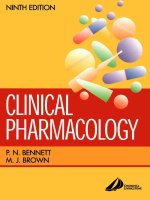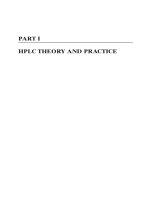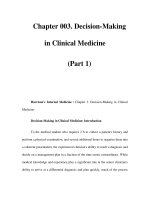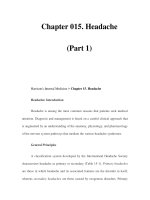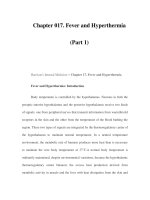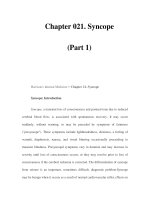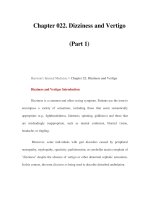Chapter 069. Tissue Engineering (Part 1) doc
Bạn đang xem bản rút gọn của tài liệu. Xem và tải ngay bản đầy đủ của tài liệu tại đây (37.42 KB, 5 trang )
Chapter 069. Tissue Engineering
(Part 1)
Harrison's Internal Medicine > Chapter 69. Tissue Engineering
Tissue Engineering: Introduction
The origins of tissue engineering date to the sixteenth century when
complex skin flaps were used to replace the nose. Modern tissue engineering
combines the disciplines of materials sciences and life sciences to replace a
diseased or damaged organ with a living, functional substitute.
The most common tissue engineering approach combines cells and matrices
to produce a living structure (Fig. 69-1). These strategies also include the use of
scaffolding, cells, and growth factors to shape new tissues. The term regenerative
medicine has emerged as a concept inclusive of tissue engineering and stem cell
therapy (Chap. 67).
Figure 69-1
Schematic of basic principles of tissue engineering.
[From Langer R, Vacanti J: Tissue engineering. Science 260:1993 (Fig. 1),
with permission.]
Cellular Components of Tissue Engineering
The foundation of tissue engineering is the combination of a three-
dimensional scaffold with live and functional cells. Cells used in tissue
engineering should be easily accessible and capable of proliferation while
maintaining their differentiated function. There are three possible sources for cells:
autologous, allogenic, and xenogenic.
Autologous cells are isolated directly from the patient. They have the
advantage of avoiding immune-mediated rejection. However, a potential limitation
is that they may not be available or able to proliferate to the required tissue mass.
Allogenic cells are harvested from a donor other than the patient. They have
the advantage of being more readily available, but the immune system must be
modulated to avoid rejection.
Xenogenic cells, or those from a different species, may also be used but
also risk immune rejection or transmission of animal pathogens.
Although cells such as fibroblasts and smooth-muscle cells proliferate
rapidly, other cells proliferate slowly or lose their tissue-specific function when
cultured, thereby limiting their use. In addition, cellular characteristics may
depend on their location within the body.
For example, the cell-to-cell interactions and function of endothelial cells
in the pulmonary microvasculature are different from those in the blood-brain
barrier.
The microenvironment of the cell, including the presence of other cell
types, soluble factors, and the presence of physical or mechanical forces may also
alter the function of a transplanted cell.
Stem cells provide a promising cell source because they are capable of
rapid proliferation and they can be induced to differentiate into multiple cell
lineages (Chaps. 66 and 67).
Human embryonic stem cells are capable of differentiating into endoderm,
mesoderm, or ectoderm tissue types. Multipotent adult stem cells have been found
in multiple mature tissues including the bone marrow, brain, heart, and liver. In
addition to being able to differentiate into numerous lineages, adult stem cells
generate a relatively muted immune response.
